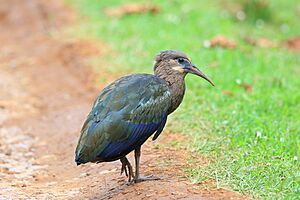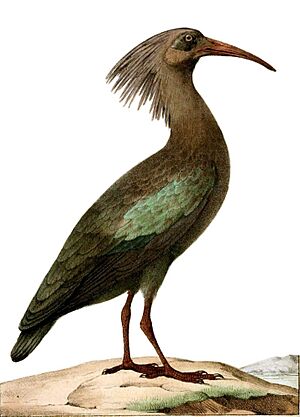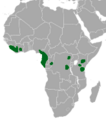Olive ibis facts for kids
Quick facts for kids Olive ibis |
|
|---|---|
 |
|
| Young B. o. akleyorum at Mt Kenya – it doesn't have the long crest like adult birds |
|
| Conservation status | |
| Scientific classification | |
 |
|
| Where the olive ibis lives today (IUCN, 2012) |
The olive ibis (Bostrychia olivacea) is a type of ibis bird. It lives in thick tropical forests in central Africa. This ibis is quite small, usually 65 to 75 cm long. It has olive-colored feathers that shine with different colors. There are four main types, or subspecies, of the olive ibis.
Contents
About the Olive Ibis: Its Family Tree
Scientists first put the olive ibis into different bird groups. But now, it belongs to the Bostrychia group of ibises. It's also related to the Madagascar crested ibis and other Geronticus ibises.
There are four recognized types of olive ibis: Bostrychia olivacea olivacea, B. o. cupreipennis, B. o. akleyorum, and B. o. rothschildi. The dwarf olive ibis from São Tomé used to be considered a type of olive ibis. But now, it's a separate species. This is because it's much smaller and looks different.
These different types of olive ibises live in various parts of Africa. Even though they might be slightly different in size or color, they are still the same species. They probably became separate types because large grasslands or seas kept them apart. This stopped them from moving between their forest homes. This is also likely how the dwarf olive ibis became its own species.
What the Olive Ibis Looks Like
Appearance and Size
This ibis is a medium-sized bird, about 65 to 75 cm long. Its exact size depends on which type it is. For example, the akleyorum type is the largest and has the longest beak. However, scientists haven't studied many of these birds. So, they aren't completely sure if these size differences are always true.
Adult olive ibises have dull brown feathers. These feathers have shiny green and bronze colors. Their head and neck are also brown. They have light stripes under their eyes. The skin around their eyes and beak is bluish-black. Their beak is a bright coral red. Their tail feathers are dark blue. Their back and rump are a dusky greenish-bronze color. The feathers on their wings are pinkish-green, which makes them stand out. Their legs and feet can be dull dark red, yellowish-green, or pinkish-brown. These different colors might depend on whether the bird is ready to breed.
The colors can be a bit different between the types. The olivacea type has a warm brown color. The akleyorum type has a greener back and green wing feathers. The olivacea type has coppery-brown wing feathers. The cupreipennis type has more green on its neck and body than the olivacea type. The rothschildi type has a purplish-blue rump with olive-green reflections.
The olive ibis has a special brown crest (a tuft of feathers on its head). This crest is purple near its neck. This helps tell it apart from similar birds like the hadada and spot-breasted ibises. The purple color is more spread out on the crest of the rothschildi type. You usually can't see the crest when the bird is flying because its neck is stretched out. It's very hard to tell the olive ibis and spot-breasted ibis apart just by looking at them in the wild. But the akeleyorum type looks heavier than the hadada ibis and has a thicker neck.
This ibis flies strongly, even if it looks a bit clumsy. Its wingbeats are like those of night herons. It's hard to spot in the wild. You're more likely to see it flying at dawn or dusk. Some akeleyorum ibises have been seen flying very high, about 800 feet above the forests. They are probably flying to mountain forests to sleep. Young olive ibises have brownish-black fluffy feathers. They don't have the long crest that adult birds have.
What the Olive Ibis Sounds Like
The olive ibis makes a loud, squawky sound like “gar-wa.” It repeats this sound several times while flying high above the trees. It usually only calls when flying, and only during twilight (dawn or dusk). The rothschildi type has a different call, described as “HAAN-ha HAAN-ha.” Other calls sound like “aka-a,” “ka,” and “kau.” If it feels threatened, it will repeat the “ga” sound. Scientists haven't heard its calls near its nest. This might be because the sound of rushing water hides any noises. This ibis stays quiet during the day when it's looking for food, so it's hard to find then.
The olive ibis's call sounds rough but steady. It's different from the loud, three-part shriek of the hadada ibis. The spot-breasted ibis's call doesn't have the honking sound of the olive ibis. Also, the olive ibis doesn't stress the second part of its call like the spot-breasted ibis does. So, the way it calls is a better way to tell the olive ibis and spot-breasted ibis apart than how they look.
Where the Olive Ibis Lives
This bird lives in patches of thick forests across tropical Africa, from the west to the east coast. You can find it in countries like Cameroon, the Republic of Congo, DR Congo, Cote d’Ivoire, Gabon, Ghana, Kenya, Liberia, Nigeria, Sierra Leone, and Tanzania. It also lives on Príncipe and São Tomé islands. Besides dense forests, it has also been seen in forests that are growing back and in cliff holes.
The different types of olive ibises live in different areas of Africa. The Bostrychia olivacea olivacea and B. o. cupreipennis types live in the west. The olivacea type is found in Upper Guinea, in countries like Sierra Leone, Liberia, and Cote d'Ivoire. The cupreipennis type is found a bit further south in Lower Guinea, in countries like Cameroon, Gabon, Republic of Congo, and DR Congo. The cupreipennis type is also more towards central Africa, while olivacea is more common on the western coast. The B. o. rothschildi type lives on Príncipe island and São Tomé.
The B. o. akleyorum type lives in the mountain forests of eastern Africa. It can be found at very high places, from 1,800 to 12,000 meters above sea level. It lives in eastern DR Congo, on Mount Kenya, in the Aberdares of Kenya, Kilimanjaro in Tanzania, on Mount Meru, and on Mount Elgon. But it doesn't seem to live in lowland forests in east Africa, like the Kakamega tropical rainforest in Kenya. However, its call was once heard in the lowlands of Uganda. You can easily tell it apart from the similar hadada ibis by where it lives. The hadada ibis lives at lower altitudes, usually below 6,000 feet in this region. The olive ibis might be the only African bird that lives only in lowland tropical forests in West Africa and only in higher mountain forests in the East.
The olive ibis probably stays in one place most of the time. But it might make short trips in Liberia during very dry weather. During these times, it moves from northern Grand Gedeh county to areas further south like Glaro, Sapo, and Sinoe.
Olive Ibis Behaviour and Life Cycle
Feeding and Roosting Habits
The olive ibis eats insects like beetles, grubs (insect larvae), and snails. It also eats myriapods (like millipedes), plants from the forest floor, and even snakes. It usually looks for food alone, in pairs, or in small groups of 5 to 12 birds. They feed in thick forest areas along small, fast-flowing streams. They also feed in mangrove swamps, marshes, and larger rivers like the St. Paul's River in Liberia. Observations in Kenya suggest that this ibis might prefer to find food on the forest floor where there isn't much undergrowth.
The olive ibis likes to sleep at night in the tops of large, dead trees, such as silk-cotton trees. It probably uses the same trees every night. It seems to use the same paths every day to fly between its sleeping and feeding spots. When it lands on a tree branch, it doesn't land straight on it. Instead, it lands along the length of the branch and runs a short distance after landing.
Reproduction and Nesting
This ibis nests by itself. The first time its breeding was recorded was in 1910 on Mount Kenya. Later, nests were found near water in East Africa. One nest was found near the Pesi River in the northern Aberdares. Another was found near the Thiririka River in the southeastern Aberdares. Both nests were 20–40 cm wide. They were placed 2–4 meters above the water and seemed to be balanced on thin branches. The nest is usually made loosely from dead branches and looks surprisingly shaky for a bird its size. Both the male and female birds have been seen building the nest quietly. So far, only nests of the akleyorum type have been found. But other types probably build similar nests in similar places. The only breeding record in West Africa comes from Liberia in June.
Based on the few known breeding records in Kenya, the birds seem to lay eggs from June to August. A female usually lays three eggs. The eggs are pea green with reddish-brown stains and chestnut-brown marks. An egg typically weighs about 50g and measures 56-58 x 40-41mm.
Threats to the Olive Ibis
This bird is in danger because people hunt it and its forest home is being destroyed. Other dangers might include being eaten by forest birds and mammals like the olive baboon (Papio anubis) and yellow baboon (P. cynocephalus). However, scientists don't know the full extent of these threats because it's hard to count how many olive ibises there are.
When disturbed, the olive ibis flies away silently and hides itself in trees with thick leaves.
Olive Ibis and Humans
People have never kept this ibis in zoos or as pets. No live olive ibises have ever been brought to Europe. However, many dead specimens (preserved birds) are kept in museums around the world. You can find them in places like Brussels, Paris, Philadelphia, Leyden, and Lisbon. Specimens of the akleyorum type are also in the Nairobi Museum and the British Museum.
Conservation Status
The IUCN (International Union for Conservation of Nature) says the olive ibis is of Least Concern. This means its population isn't low enough to be considered "Vulnerable" yet.
It's hard to count these birds because they are very secretive and live in places that are difficult to reach. Scientists estimate there are between 3,000 and 25,000 olive ibises in the wild. It's not globally threatened, but its population is thought to be decreasing because of deforestation (forest destruction) and hunting. However, this decline isn't considered big enough to make the species vulnerable. Because it's hard to spot these birds in the wild, there might be more of them than we know, especially since their calls are often heard.
The rothschildi type was thought to be extinct on Príncipe island in 1901. However, it was last seen there in 1991. A small group of fewer than 10 birds might still live on this island.
Images for kids
-
Immature B. o. akleyorum at Mt Kenya – it lacks the long crest found in adults






